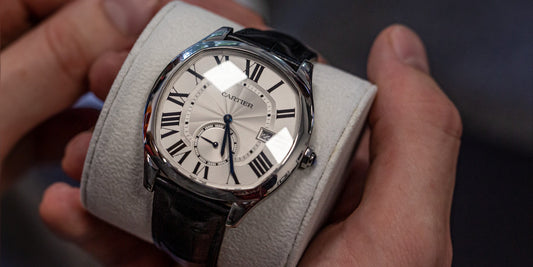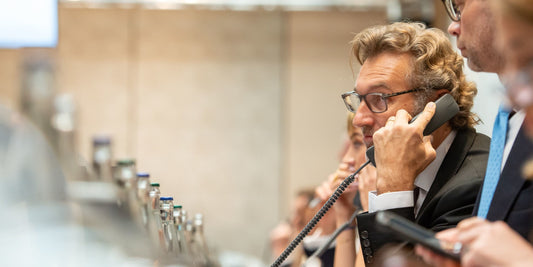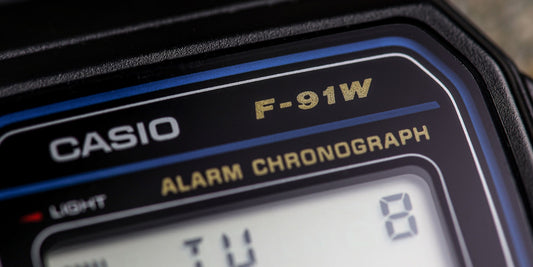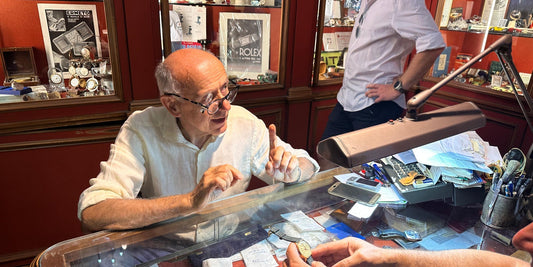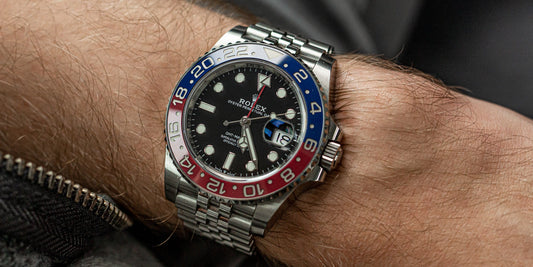One of the first things that Vincent Montalescot did when he started working for Montblanc as Chief Marketing Officer was to order a load of letterboxes.
It must have left his colleagues somewhat confused, wondering whether or not they had inadvertently hired Postman Pat rather than an experienced marketeer.
 Vincent with one of his famous postboxes - Credit WatchGecko
Vincent with one of his famous postboxes - Credit WatchGecko
But this was just a symptom of Vincent’s uncanny ability to home in on the very essence of a brand. He immediately saw that Montblanc is all about writing: so the letterboxes were for people to hand-write a postcard while they were visiting a Montblanc store, experiencing for themselves the company’s core values.
To write a postcard, you need to think and you need to take time. And that’s how Vincent explains the synergy between writing and watches, with Montblanc having only been a watchmaker since 1997 – although the company itself has existed since 1906, making pens and leather goods; most famously the Meisterstuck fountain pen, which means ‘masterpiece’ in English. No surprise that this was also the name given to that very first Montblanc watch collection.
 Montblanc 1858 Automatic Date 0 Oxygen The 8000 - Credit Montblanc
Montblanc 1858 Automatic Date 0 Oxygen The 8000 - Credit Montblanc
There’s of course a much bigger family behind Montblanc these days. In 1985, it became part of Dunhill, which was subsequently absorbed by what we know now as the Richemont Group (the owners of Langhe and Sohne, Cartier, IWC and Panerai, among many others).
Perhaps the most significant moment in the brand’s watchmaking history came in 2006, when Richemont acquired Minerva – first founded in 1859 – as a subsidiary of Montblanc. This allowed Montblanc to effectively short-cut horological history, thanks to Minerva’s reputation for high-end watchmaking.
That renown was reinforced this year, with Minerva coming up with a remarkable chronograph with no pushers, also available in the company’s signature ‘lime gold’ – gold with a greenish tinge.
 K2 detailing on the back of the current Messner - Credit Montblanc
K2 detailing on the back of the current Messner - Credit Montblanc
As a marketer, Vincent – who previously spent 17 years at sportswear brand Adidas – makes it his mission to emphasise everything about Montblanc that is unique. This year, it’s the mountain heritage: what many people think is a white star as the Montblanc logo is in fact a stylised depiction of the snow-capped peak of Mont Blanc itself.
Among the latest releases are watches named after famous mountaineers, such as Reinhold Messner, as well as the zero oxygen watch, which operates in a vacuum. Messner, as well as being a mountain climber (and politician) has also written 80 books. That’s key to his relationship with the brand.
“We have something truly unique at Montblanc, which is writing,” says Vincent. “We’re not talking about the brand itself here, but instead how you differentiate yourself as a brand. So, what I saw straight away is that are not many watch brands with an element like this one. Our name and emblem speak for themselves; they bring you to the mountain. From there, you have a field of play that you can tap in to, as this is what makes it authentic if we are doing it right.”
 Montblanc 1858 Geosphere 0 Oxygen The 8000 42mm- Credit Montblanc
Montblanc 1858 Geosphere 0 Oxygen The 8000 42mm- Credit Montblanc
It's a neat answer to the world's oldest question regarding marketing watches: how do you cut through the noise and make a genuine difference to position your brand as the one that people want to buy?
“You differentiate yourself by using the elements that are unique to you,” adds Vincent. “I’ll give you another example. We’ll soon be basing another international campaign on the theme of ‘the library’. That’s the soul of any city in the world, and it’s where you play with words, as words mean writing. The way to engage with people is to be true to who you are.”
 Anthony and Vincent deep in conversation - Credit WatchGecko
Anthony and Vincent deep in conversation - Credit WatchGecko
That’s a code that Vincent applies equally to himself. Although he spent 20 years in the sports industry, he’s a keen skier and lover of mountains (where he wears the zero oxygen watch) and grew up in a family with a small boutique selling jewellery and watches.
“So I was pleased to enter a business that I had seen from a different perspective; more from the front line,” he adds. “When I got the call to ask me if I was interested to join Montblanc five years ago, I didn’t need to know anything more about the brand, as in terms of image it’s right up there with the best in the world. What really convinced me was when I went to the manufacture, and I was blown away. Then I knew straight away that I would take on this challenge: to re-invigorate the brand as Nicolas Baretzki [Montblanc’s CEO] wanted.”
As well as ordering those mailboxes, Vincent set himself the task of sorting through several old boxes, some of which hadn’t been opened for a century. Not a conventional first day at work, but Vincent isn’t a conventional type of guy.
“I consider this role as a gift; driving a brand like this is a true privilege,” he continues. “I’m not a genius but I do have a sense of logic. So first thing: I needed access to the archive. I looked in boxes that had not been opened for 100 years and I still look at them now. To understand the future of the brand, first you have to understand the past.”
 Vincent flanked by some of Montblanc's 2023 creations - Credit WatchGecko
Vincent flanked by some of Montblanc's 2023 creations - Credit WatchGecko
Not only that but Vincent likes to define a watch brand as he would define a real person; getting to know their preferences and personality. So what is this mythical Mr Montblanc like?
Vincent thinks carefully before answering; pointing out that we could be talking about Mrs Montblanc too. And to make the point that he’s being authentic rather than needlessly woke, he adds that one of his predecessors at Montblanc in the 1920s, who sat on the company’s board (as he does), was a woman: avant-garde for the time.
“I spend a lot of time thinking about these insights and bridging our heritage to the modern day: defining the personality of the brand and connecting the brand to the person,” he explains. “This person – they like details; they pay attention to detail. I believe that this person is going through a journey with different steps. I see someone who wants to leave a mark and express themselves differently. Someone who wants to inspire other people. They push boundaries and love writing. And they appreciate the combination of craftsmanship and innovation.”
The Montblanc community is an eclectic one: this year, the emphasis is on mountains (you’ll find a stunning engraving of K2 on the back of the Messner watch) but in the past there have been collaborations with companies as diverse as Porsche in the 1960s, as well as Pirelli and Ferrari during more recent years. Then there’s the relationship with the other Richemont watch brands. Although Montblanc is completely standalone from its stablemates, Vincent says, “We speak regularly and learn from each other. We don’t see each other as competitors, but more like brothers and sisters.”
As marketers, Vincent and his opposite numbers from the different Richemont brands have a similar mission: to try and see into the future and understand what will make people buy the watches. That’s perhaps the hardest part of his job, because his bosses have to see him as a sort of horological Nostradamus.
“We have at least a two-year lead time,” he points out. ‘My role is to tell Laurent, the managing director, where the brand will be – or should be – in the next two to three years; identifying the different themes and territories that we want to tap into. The next question is: how would you plug the watch category into that? What comes next from a brand perspective? And then we start to connect and engage and fine tune the plan. I’ve known what's coming next for a while already, but unfortunately I can’t tell you!”
 Montblanc 1858 - Credit Montblanc
Montblanc 1858 - Credit Montblanc
He makes predicting the future almost easy, or using his own words, like mixing a cocktail. He takes the latest trends and the views of the media and clients as his first ingredients. Then he adds a touch of heritage and a sprinkling of his own ideas. “You shake it all together, taste it, and then share it with the leaders in the different categories. There’s your cocktail.”
Think that’s just a casual metaphor? Vincent points me in the direction of the plush cocktail bar installed in a corner of the beautiful Montblanc stand at the Watches and Wonders show in Geneva, dominated by a giant golden pen nib. There, you’ll find a list of cocktails: each one inspired by a watch. Everything he says is for a reason.
But predicting the future isn’t actually as hard as it sounds, because it’s all based on the past. “You’re never working with a blank page in this job, as if you go somewhere random, you lose where you are,” concludes Vincent. “Your future is based on yourself and your past. Your personality might evolve over the years, but the fundamentals always stay the same. If I turn up for work tomorrow wearing a pink wig, I’m still me.”
You have the impression that he might actually do that one day – just to prove a point that we already know. Time is a fundamental truth, so the way that you present it has to be authentic.


